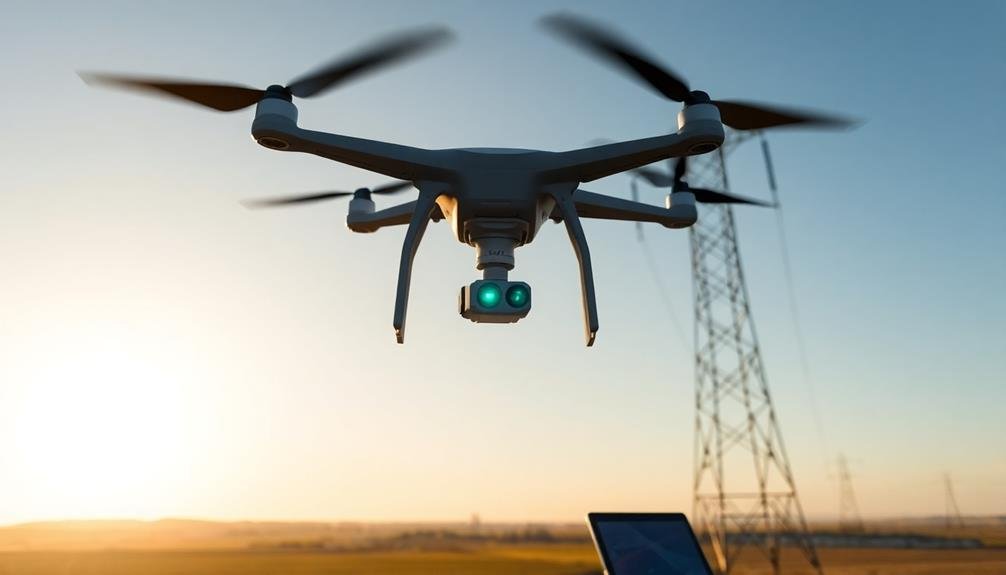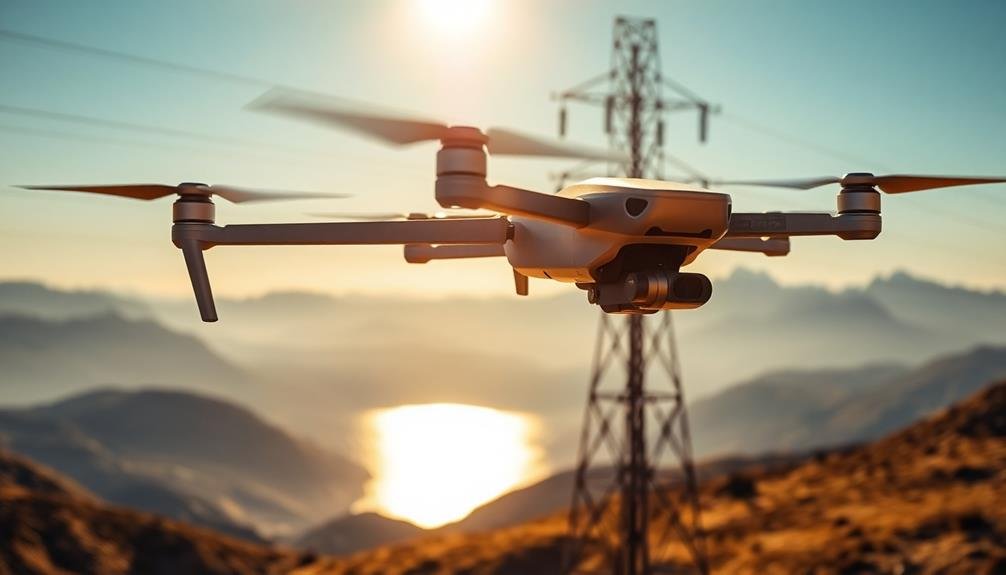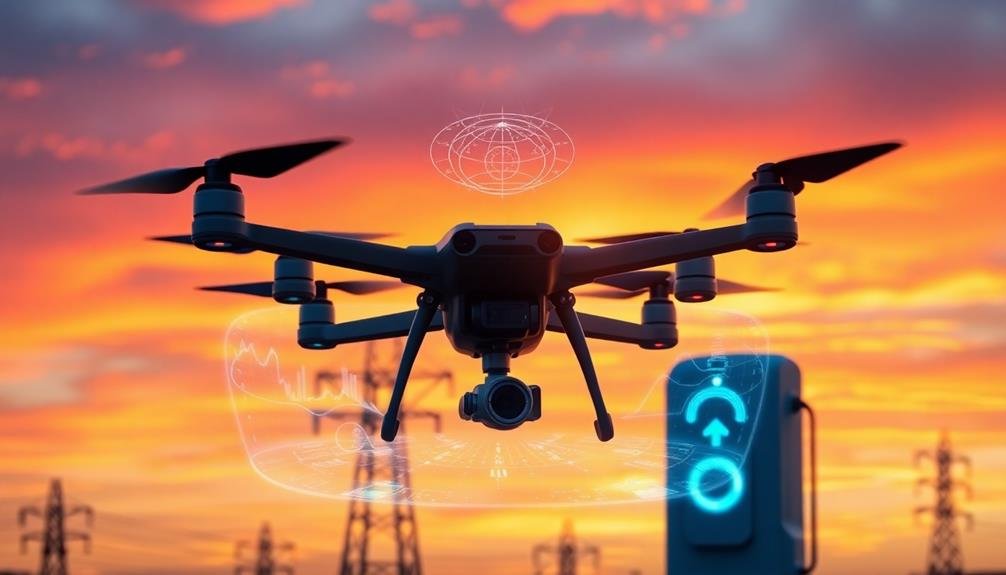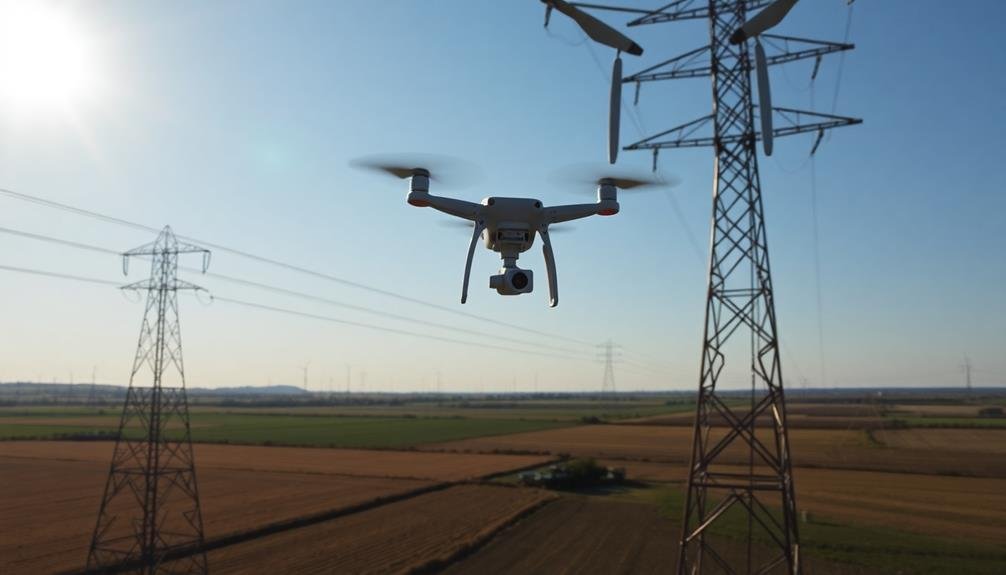Aerial UAVs are revolutionizing power line inspections, offering a safer, more efficient, and cost-effective alternative to traditional methods. You'll find that drones equipped with high-resolution cameras, thermal sensors, and LiDAR can quickly cover large areas, accessing hard-to-reach spots without risking human lives. They're reducing labor costs, minimizing downtime, and providing higher quality data for predictive maintenance. UAVs allow for more frequent inspections without interrupting power supply, enhancing overall grid reliability. From automated flight paths to machine learning algorithms for rapid issue identification, these aerial inspectors are transforming the industry. The future of power line maintenance is taking flight, and there's much more to explore.
Key Takeaways
- UAVs offer cost-effective, safer alternatives to traditional ground-based and helicopter inspections of power lines.
- Drones equipped with high-resolution cameras and thermal sensors provide detailed imagery for efficient fault detection.
- Automated flight paths and machine learning algorithms enable quick identification of potential issues in power line infrastructure.
- UAV inspections reduce downtime by allowing for more frequent checks without interrupting power supply.
- Integration of advanced sensors like LiDAR and hyperspectral imaging enhances structural analysis capabilities of aerial inspections.
Traditional Power Line Inspection Methods

While power line inspection has been a crucial part of maintaining electrical infrastructure for decades, traditional methods have often been time-consuming and potentially dangerous. You'll find that utility companies have relied on several conventional techniques to assess the condition of power lines and identify potential issues.
One common approach involves ground-based visual inspections. You'll see workers using binoculars or telescopes to examine power lines from the ground, looking for visible damage or irregularities. This method is limited by distance and obstructions, making it challenging to spot subtle problems.
Another traditional technique you'll encounter is helicopter-based inspections. Utility companies deploy crews in helicopters to fly alongside power lines, capturing high-resolution images and video footage. While more thorough than ground-based methods, this approach is expensive and poses safety risks to personnel.
You'll also find that some utilities use climbing inspections, where trained technicians physically climb transmission towers to conduct up-close examinations. This method provides detailed insights but is slow, labor-intensive, and potentially hazardous for workers.
Lastly, you'll see thermal imaging cameras used to detect hot spots on power lines, indicating potential equipment failures or energy losses.
Benefits of UAV Inspection Technology

You'll find that UAV inspection technology offers significant advantages for power line maintenance.
By employing drones, you can implement cost-effective solutions that reduce the need for manual inspections and expensive equipment.
Furthermore, you'll enhance safety measures by minimizing the risks associated with human inspectors working at heights or in hazardous conditions.
Cost-Effective Maintenance Solutions
How can power companies streamline their maintenance processes while reducing costs? UAV inspection technology offers a cost-effective solution that's revolutionizing the power line maintenance industry. You'll find that drones can considerably cut down on expenses associated with traditional inspection methods while improving efficiency and safety.
By adopting UAV technology for power line inspections, you'll benefit from:
- Reduced labor costs: Fewer personnel are needed for inspections, cutting down on man-hours and associated expenses.
- Decreased equipment requirements: No need for expensive helicopters or heavy machinery, lowering overall operational costs.
- Faster inspection times: Drones can cover large areas quickly, allowing for more frequent inspections without increasing costs.
- Minimized downtime: UAVs can inspect live lines without interrupting power supply, reducing revenue losses from outages.
You'll also save on insurance premiums as UAV inspections are inherently safer than manual methods.
The high-quality data collected by drones enables predictive maintenance, helping you address potential issues before they become costly problems.
With UAVs, you can optimize your maintenance schedule, prioritize repairs, and allocate resources more effectively, ultimately leading to considerable long-term cost savings for your power company.
Enhanced Safety Measures
Safety harnesses and hard hats can't protect workers from every hazard when inspecting power lines. That's where aerial UAVs come in, revolutionizing the inspection process and greatly enhancing safety measures. By using drones, you'll keep your workers on the ground, away from potential electrical hazards and falls from great heights.
UAVs can access hard-to-reach areas and collect high-resolution imagery without putting human lives at risk. They'll navigate through challenging terrains and weather conditions that might be dangerous for your team. You'll reduce the need for helicopter inspections, which pose their own set of risks.
With UAVs, you can conduct more frequent inspections without compromising safety. They'll help you detect potential issues early on, preventing accidents caused by equipment failure. You'll also minimize traffic disruptions and road closures associated with traditional inspection methods.
These drones come equipped with advanced sensors and cameras, allowing you to capture detailed data without exposing workers to electromagnetic fields. You'll improve overall workplace safety while maintaining efficient power line inspections.
Types of UAVs for Line Inspection

When considering UAVs for power line inspection, you'll encounter two main types: fixed-wing and rotary-wing aircraft.
Fixed-wing UAVs offer longer flight times and greater range, while rotary-wing models provide better maneuverability and hovering capabilities.
Your choice between these types will depend on the specific inspection requirements and payload capacity needed for sensors and cameras.
Fixed-Wing vs. Rotary-Wing UAVS
While both fixed-wing and rotary-wing UAVs can be used for power line inspection, each type has its own strengths and weaknesses.
Fixed-wing UAVs excel at covering large distances efficiently, making them ideal for inspecting long stretches of power lines. They're more aerodynamic and can stay airborne for extended periods, allowing you to survey vast areas in a single flight. However, they require more space for takeoff and landing, which can be challenging in densely populated or forested areas.
Rotary-wing UAVs, on the other hand, offer superior maneuverability and hover capability. You'll find them particularly useful for detailed inspections of individual pylons, transformers, or hard-to-reach areas. They can take off and land vertically, making them more versatile in confined spaces.
When choosing between fixed-wing and rotary-wing UAVs, consider these factors:
- Inspection area size
- Required level of detail
- Terrain and obstacles
- Flight time requirements
Your specific inspection needs will determine which type of UAV is best suited for the job. By understanding the strengths and limitations of each, you can make an informed decision and optimize your power line inspection process.
Payload Capacity Considerations
Beyond the choice between fixed-wing and rotary-wing UAVs, payload capacity plays a key role in determining the effectiveness of your power line inspection drone.
You'll need to take into account the weight and size of the sensors and cameras you'll be using, as they directly impact the drone's flight time and range.
For basic visual inspections, a lightweight camera might suffice, allowing for a smaller drone with longer flight times.
However, if you're planning to use more advanced sensors like thermal cameras or LiDAR systems, you'll need a UAV with a higher payload capacity.
These heavier payloads will require a more powerful drone, which often comes at the cost of reduced flight time.
When selecting your UAV, evaluate the specific inspection tasks you'll be performing.
If you need to carry multiple sensors simultaneously, opt for a drone with modular payload options.
This flexibility allows you to swap out equipment as needed, maximizing the utility of your UAV.
Additionally, factor in any future sensor upgrades you might implement to guarantee your chosen drone can accommodate them without compromising performance or safety.
Sensor Payloads for Aerial Inspections

Sensor payloads play an essential role in aerial power line inspections. You'll find that these specialized devices are designed to capture high-quality data about power line conditions, allowing for efficient and accurate assessments.
When selecting sensor payloads for your UAV, you'll need to take into account the specific inspection requirements and the drone's payload capacity.
Here are four common sensor payloads used in aerial power line inspections:
- High-resolution cameras: Capture detailed images of power line components
- Thermal imaging cameras: Detect heat anomalies in electrical equipment
- LiDAR sensors: Create 3D models of power line infrastructure
- Corona detection cameras: Identify electrical discharge and insulation issues
You'll want to choose sensor payloads that complement each other and provide extensive data for your inspection needs. For example, combining high-resolution and thermal imaging cameras can help you identify both visible damage and hidden heat-related issues.
It's vital to confirm that your chosen sensors are compatible with your UAV's onboard systems and data transmission capabilities.
Data Collection and Analysis Techniques

Efficiency is key when it comes to data collection and analysis techniques for aerial power line inspections. You'll want to focus on capturing high-quality imagery and sensor data while minimizing flight time and data storage requirements.
Use automated flight paths and pre-programmed waypoints to guarantee consistent coverage of power line corridors.
To streamline data analysis, implement machine learning algorithms that can quickly identify potential issues like vegetation encroachment, damaged insulators, or loose connections. You'll benefit from real-time data processing onboard the UAV, which allows for immediate identification of critical problems during the flight.
Don't forget to integrate your collected data with existing GIS and asset management systems. This integration enables you to track the condition of power line components over time and predict maintenance needs.
You should also employ cloud-based storage and processing solutions to handle the large volumes of data generated during inspections.
Regulatory Considerations for UAV Operations

When operating UAVs for power line inspections, you'll need to navigate a complex web of regulations. These rules are designed to guarantee safety, protect privacy, and maintain order in the airspace. You'll encounter federal, state, and local laws that govern UAV operations, each with its own set of requirements and restrictions.
To stay compliant, you must:
- Obtain proper licensing and certifications
- Register your UAV with the FAA
- Follow airspace restrictions and obtain necessary clearances
- Adhere to visual line-of-sight requirements
You'll need to familiarize yourself with the FAA's Part 107 rules, which cover commercial drone operations. These regulations include limitations on flight altitude, speed, and operating times.
You'll also need to take into account privacy laws when flying near residential areas or capturing images of private property.
Insurance requirements are another vital aspect of regulatory compliance. You'll need to secure adequate liability coverage to protect yourself and your company in case of accidents or property damage during inspections.
Stay up-to-date with changing regulations, as UAV laws are continually evolving. Regularly check for updates from the FAA and local authorities to guarantee your operations remain compliant and efficient.
Cost-Effectiveness of Drone Inspections

Despite initial investment costs, drone inspections offer significant long-term savings for power line maintenance.
You'll find that UAVs reduce labor expenses by replacing manual inspections, which often require teams of workers and specialized equipment. Drones can cover large areas quickly, increasing efficiency and allowing for more frequent inspections without additional costs.
You'll also save on safety-related expenses. By minimizing the need for workers to climb towers or use helicopters, you'll reduce accident risks and associated insurance costs. Drones can access hard-to-reach areas safely, providing detailed imagery that helps identify potential issues before they become costly problems.
Moreover, you'll benefit from improved data quality. High-resolution cameras and sensors on drones capture detailed information, enabling more accurate assessments and targeted maintenance. This precision helps you allocate resources more effectively, focusing on areas that truly need attention.
When considering cost-effectiveness, factor in the drone's versatility. You can use the same equipment for various inspection tasks, from vegetation management to thermal imaging, maximizing your return on investment.
As drone technology advances, you'll find even more applications, further enhancing the cost-effectiveness of your UAV inspection program.
Future Trends in Aerial Inspection

In the domain of aerial inspection, emerging technologies are set to revolutionize how you'll conduct power line maintenance. As drones become more sophisticated, you'll see a shift towards fully autonomous inspections, reducing human intervention and increasing efficiency. AI and machine learning algorithms will play a significant role in analyzing collected data, providing real-time insights and predictive maintenance recommendations.
You can expect these future trends in aerial power line inspection:
- Integration of LiDAR and hyperspectral imaging for more detailed structural analysis
- 5G connectivity enabling real-time data transmission and remote operation
- Swarm technology allowing multiple drones to work collaboratively for faster inspections
- Advanced sensor fusion combining thermal, visual, and electromagnetic data for thorough assessments
These advancements will lead to faster, more accurate inspections and improved safety for utility workers.
You'll also see a rise in edge computing, allowing drones to process data on-board and make autonomous decisions. As regulations evolve, beyond visual line of sight (BVLOS) operations will become more common, expanding the reach and capabilities of aerial inspections.
Prepare for a future where drones are an indispensable tool in maintaining and optimizing power infrastructure.
Frequently Asked Questions
How Do UAVS Handle Extreme Weather Conditions During Power Line Inspections?
You'll find UAVs equipped with weatherproof designs to handle harsh conditions. They're built with stabilizers for strong winds, thermal cameras for fog, and protective coatings for rain. Some even have de-icing systems for snowy inspections.
What Training Is Required for Operators of UAVS in Power Line Inspections?
You'll need extensive training to operate UAVs for power line inspections. You must master flight controls, safety protocols, and data collection techniques. You'll also need to understand electrical systems, weather patterns, and relevant regulations. Don't forget ongoing certifications too.
How Do UAVS Avoid Interfering With Wildlife During Aerial Inspections?
You'll use UAVs equipped with wildlife detection sensors to spot animals. You'll fly at safe altitudes and maintain distance from nests or habitats. You'll also schedule flights during low-activity periods and avoid breeding seasons when possible.
Can UAVS Be Used for Emergency Repairs on Power Lines?
You can't use UAVs for direct emergency repairs on power lines, but they're valuable for quick assessments. They'll help you identify damage, guide repair crews, and monitor conditions, speeding up response times and improving safety.
How Do Power Companies Integrate UAV Data With Existing Asset Management Systems?
You'll find power companies integrating UAV data into their asset management systems through specialized software. They'll import inspection imagery, sensor readings, and GPS data, then sync it with existing records for an extensive view of their infrastructure.
In Summary
You've seen how UAVs are revolutionizing power line inspections. They're faster, safer, and more cost-effective than traditional methods. As regulations evolve and technology advances, you'll witness even more innovative applications. Remember, drones aren't just tools; they're game-changers in infrastructure maintenance. By embracing this technology, you're not only improving efficiency but also enhancing safety for workers and reliability for consumers. The future of power line inspection is airborne, and it's here to stay.

As educators and advocates for responsible drone use, we’re committed to sharing our knowledge and expertise with aspiring aerial photographers.




Leave a Reply